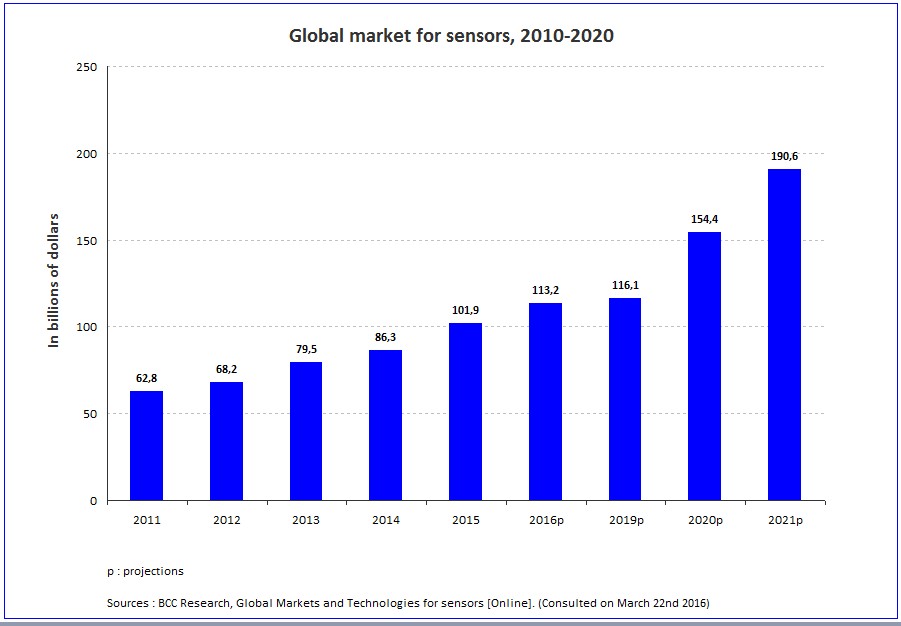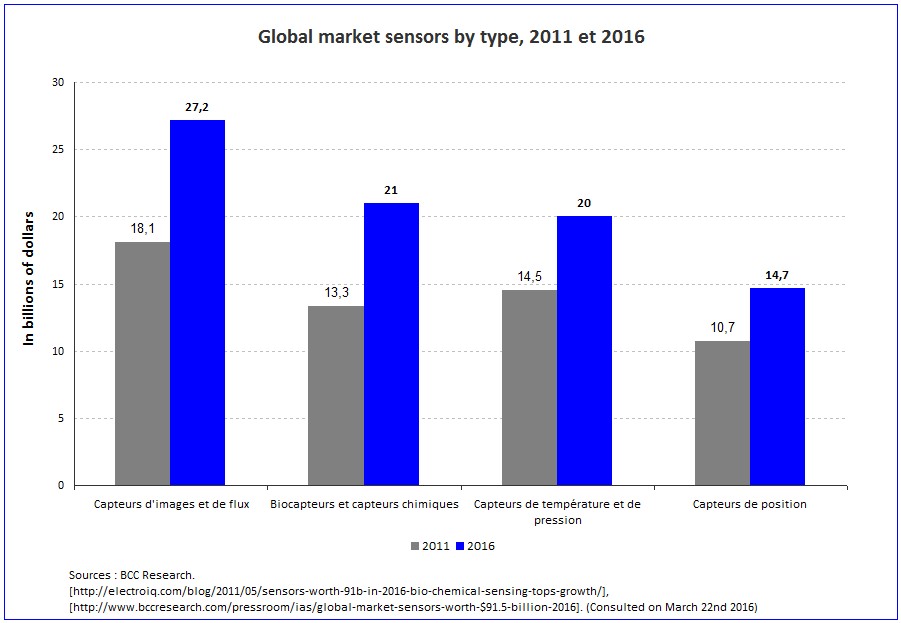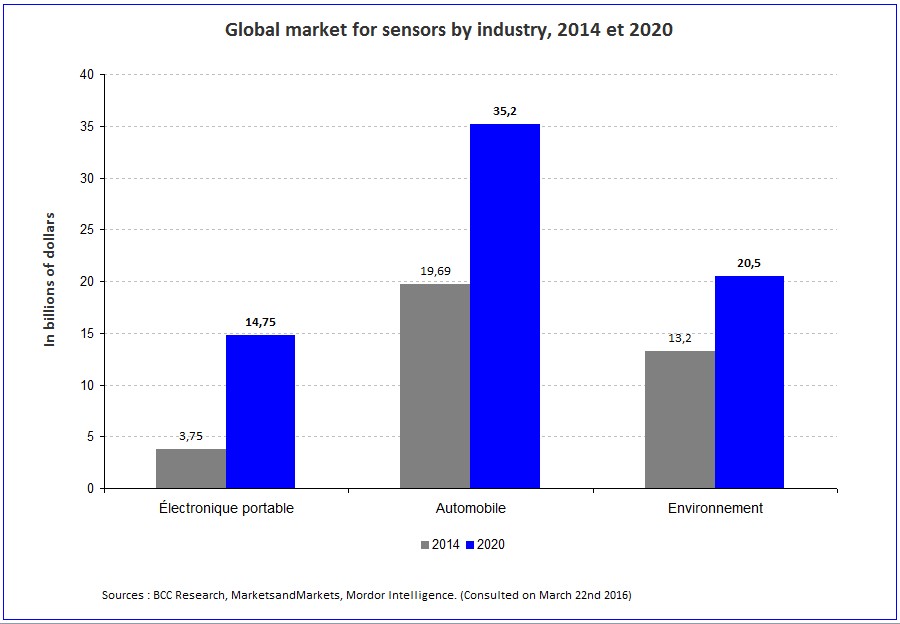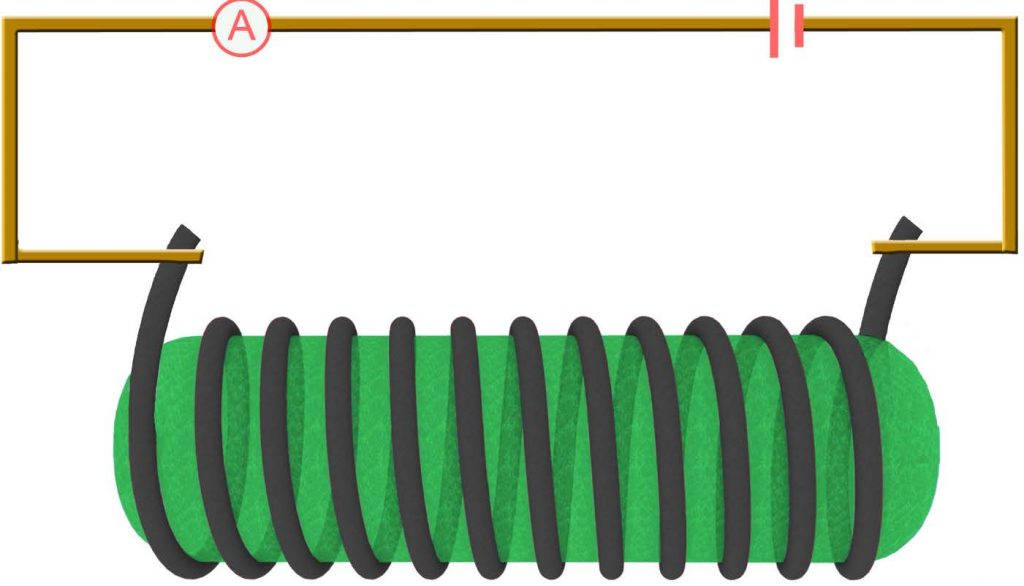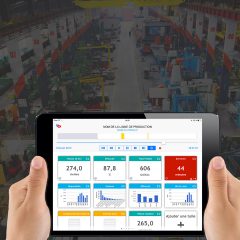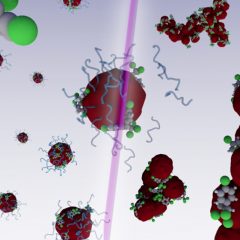Sensors instantaneously measure information on a given environment and transmit it using a signal emitted by a software tool.
Imagine, for example, a sensor integrated into a city lamppost to detect a defective bulb and automatically send the related information by Internet, without the physical presence of an agent. The sensor industry represents a market valued at $102 billion worldwide (in 2015), with applications in a wide variety of sectors, including electronics, cars, chemistry, health and aeronautics. This market is expected to reach the $113 billion mark by 2016, and about $191 billion within the next five years.
There are several types of sensors. Among the best known are the following :
- Biosensors and chemical sensors are used to transform a biochemical signal into an electrical signal. For example, they can be used to monitor the quality of food products in real time and detect the chemical composition of plastic materials. This type of sensor is generally used in the agri-food, health, chemistry and environmental sectors.
- MEMS sensors (Micro-Electro-Mechanical Systems) are miniature electromechanical devices that make it possible to measure a variety of parameters, such as temperature, pressure, motion or position. In the automotive sector, they are used to measure the automation of tollbooths or electronically monitor electric vehicle charging phases.
- Optical sensors are used to convert information provided by light into an electrical signal. Image sensors represent the best-known category of optical sensors. They are used in transportation, notably in self-driving or driverless cars, to detect obstacles at night.
New-generation sensors differ from traditional sensors. In addition to being wireless, they consume less energy and are inexpensive. These sensors have an important role to play in the development of new industrial applications. In particular, they offer prospects for innovation in such fields as intelligent transportation, wearables, the environment and chemistry, and even in the smart building industry.
- Wearables include smart clothing and smart accessories featuring electronic components that allow users, among other things, to monitor health parameters in real time.
- Smart buildings are energy-efficient buildings that integrate intelligent and automated management of the equipment they contain (lighting, energy, air-conditioning, etc.). They may be comprised of commercial, institutional or residential buildings.
This publication is intended chiefly to present innovations developed by university researchers in Montréal as well as innovative solutions implemented by SMEs in Quebec’s metropolis. Above all, it is important to explain the evolution of the global sensor market as well as cite some examples of emerging industries benefitting from their use.
A fast-growing market
In 2015, sensors accounted for a worldwide market valued at more than $100 billion. Between 2010 and 2015, this market grew at a compound annual rate of 12.6%. According to forecasts for the next five years, the sensor market should gain momentum to reach more than $190 billion by 2021. Between 2016 and 2021, the global market for sensors is expected to grow by an average rate of 11% per year.
The strong growth of the global sensor market is unmatched, and it varies based on the type of sensor. According to BCC Research, a market research and analysis firm, the market for image sensors alone will surpass the $27.2 billion mark in 2016, before reaching $50.2 billion by 2020. Over the 10-year horizon from 2011 to 2020, the market for this type of sensor is thus expected to grow by an average rate of 12% per year. The biosensor and chemical sensor market is also poised to increase during the same period. Estimated at $13.3 billion in 2011, it is expected to reach the $21 billion mark by 2016 and $32.8 billion by 2020, good for an average annual growth rate of 10.5% between 2011 and 2020. The markets for temperature and position sensors are valued at $20 billion and $14.7 billion, respectively, in 2016. By the end of 2016, each will have grown by an average rate of about 7% per year since 2011.
Several industries stand to benefit from the growth of the sensor market, particularly the automotive, environmental and wearable sectors. These three industries will account for markets of $35.2 billion, $20.5 billion and $14.75 billion by 2020, respectively. Between 2014 and 2020, therefore, the sensor market in these three sectors should grow by an average rate of 7.8%, 7.6% and 25.6%, per year, respectively. The market for sensors used in the smart building industry is expected to top $3.7 billion in 2020, compared to $313 million in 2013, which corresponds to an average annual growth rate of 4% between 2013 and 2020.
Leading-edge research and development in Montreal
The growth of the market for sensors is driven mainly by advances in innovation. In Montreal, researchers are in the process of developing miniature wireless sensors that offer improved energy efficiency. These sensors can have numerous industrial applications, particularly in the following fields: chemistry and environment, smart city and transportation, health and well-being.
Environment and chemistry
The Centre de recherche sur la conception et la fabrication de microsystèmes (CoFaMic) at the Université du Québec à Montréal (UQAM) has developed sensors in the environmental field. These sensors are used to measure water pollution by placing microalgae in a microfluidic device and determine the physiological variations microalgae undergo when exposed to various pollutants. The changes are manifest in modified photosynthesis processes causing variations in oxygen production and the re-emission of these changes by fluorescence of the light absorbed. According to CoFaMic director Ricardo Izquierdo – who designed the sensor – this multisensor platform technology, initially designed for use in water treatment, could be broadened to include other networks of sensors for purposes of tracking other types of pollution. For example, sensors capable of detecting the presence of hydrocarbons in the soil could be used to signal the early stages of soil contamination. This type of monitoring system would allow the city to practice more effective environmental risk management.
Health and well-being
Professor Daniel Therriault, holder of the Canada Research Chair in Fabricating Microsystems and Advanced Materials affiliated with the Polytechnique Montréal, has developed a sensor capable of detecting the presence of a liquid. When this sensor – which is manufactured using 3D printing – is exposed to a liquid, its electrical resistance changes. Its helicoidal shape makes it possible to capture the liquid (illustrated in green in the attached image) inside the spiral. This sensor can be used in several fields, notably transportation and health. In transportation, for instance, it can serve to detect fuel leaks, while in medicine, thanks to smart textile, it can be incorporated into clothing for patients with mobility impairments.
Professor Xinyu Liu holds the Canada Research Chair in Microfluidics and BioMEMS at McGill University. His research, in part, involves the development of sensors for use in biomedical, environmental and industrial applications. He recently developed paper-based mechanical and biochemical sensors with the potential for a vast array of applications. In the medical field, the paper-based biosensor uses electrochemical detection to uncover the presence of glucose or a virus in the blood. This sensor’s originality lies in its ease of use, as it allows patients to self-perform blood tests without having to visit the hospital. Once the test is done, the patient can take a photo of the result and use a mobile device to forward it electronically to his or her physician for diagnosis. This sensor is thus advantageous in that it reduces hospital wait times as well as the costs associated with the use of medical equipment. In the industrial sector, paper-based mechanical sensors can be used to make smart packaging. For example, in a package for delivery, this sensor can be glued to delivery boxes to signal damage in real time and determine who is responsible (client or supplier).
Smart city and transportation
At the Microtechnology and Microsystems (Micro²) Laboratory of UQAM, Professor Frédéric Nabki has fostered a particular interest in manufacturing MEMS and integrated circuits. More specifically, he is involved in some 15 patent applications in the area of sensors and wireless communications. In collaboration with Professor Dominic Deslandes (UQAM), Prof. Nabki has developed a wireless transmitter-receiver that uses the least amount of energy possible to provide information for sensor applications dedicated to the Internet of Things. Sensors equipped with this technology can transmit their data for several years using miniature batteries. This innovation will benefit several industries, notably those in smart building, wearable technology, smart transportation or smart cities (e.g., smart lampposts). Using sensors equipped with this wireless technology, therefore, it is possible, for example, to transmit in real time ambient conditions, such as humidity, temperature and pressure in buildings or vehicle compartments. With this technology, infrastructure defects can also be predicted by identifying the presence of disruptive physical agents (e.g., abnormal vibrations in a bridge). These sensors can also be miniature, measuring just a few millimetres. In transportation, in fact, this technology could serve to integrate miniature sensors into motors and communicate via wireless telemetry, thus making it possible to characterize and optimize vehicle performance.
Aerospace
Professor Mohamad Sawan, director of the POLYSTIM lab at the Polytechnique Montréal, designs and implements sensors destined mainly for use in the biomedical and aerospace industries. Among his partners, he counts such world-renowned companies as Airbus, Bombardier and Thales. In collaboration with the latter two companies and with financial support of Synergetic Research and Innovation in Aerospace (CRIAQ), M. Sawan has developed smart sensors (MEMS and optical) for safety-critical avionics applications. Autonomous and wireless, the sensors he designed make it possible to reduce the energy consumed by aircrafts and the electrical wiring aboard aircrafts.
Telecommunications
At Concordia University’s Telecommunication Service Engineering Research Lab (TSE), Professor Roch Glitho has developed sensor virtualization software that makes it possible to deploy several applications on the same network of sensors. For example, if the city deploys sensors in all its lampposts for real-time detection of defects, it could re-use the same sensors, in a virtual manner, to measure the lampposts’ ecological impact, and eventually measure the pollution generated by vehicle traffic. In doing so, the city could reduce its costs. Otherwise, it would have to deploy three networks of sensors: one to detect defective lampposts, another to measure the ecological impact of the bulbs, and a third to measure vehicle pollution.
Professor Wessam Ajib’s specialty lies in green communications for wireless networks. Among other things, he designs energy-efficient communications protocols for sensor networks. His research is ultimately aimed at optimizing energy use. For example, in the case of sensor networks developed to monitor the state of real-estate or road infrastructures in real time, Professor Ajib has developed technology that makes it possible to effectively manage energy consumption from a green perspective. If these sensors are battery-powered, this technology will serve to minimize energy consumption. If powered by a renewable energy source, however, the technology also has the potential to maximize communications performance. Professor Wessam Ajib is a member of CoFaMic and the Laboratory for research on technology for ecommerce (LATECE) at UQAM.
Successful Montréal-based SMEs
The evolution of the market for sensors holds numerous development opportunities for entrepreneurs. Several Montreal-based SMEs have staked out a position in this market and are providing promising solutions for a range of industries.
Incorporated in 2010 after more than a decade of research at McGill University, the company MEMS Vision is specialized in manufacturing MEMS sensors. More specifically, it has designed an environmental sensor capable of simultaneously measuring ambient temperature and humidity with a high level of accuracy. The fields of application for this sensor are manifold and extremely diverse. It is used, in particular, in medical equipment (respiratory and ventilation systems), industrial equipment (control of manufacturing processes, food quality) as well as for products used by the greater public (smart watches and phones, smart clothing). Thanks to its expertise, MEMS Vision holds a dozen related patents. The Montreal-based company is also well represented on the international stage, with offices in Europe, the Middle East and Asia.
The company Photon etc. provides imaging solutions for a vast array of applications. In 2015, it developed an infrared-sensitive image sensor that has led to considerable advances in several sectors, including manufacturing, health, and energy. In recycling, for example, this sensor can be used to determine the chemical composition of plastic materials for more effective sorting of residual materials. In the medical field, it can be used to accurately locate cancer cells. And in the energy sector, it serves to ensure quality control on solar panels.
The company NTEO is developing wireless sensors capable of communicating together and automatically sending data to mobile devices (smart phones and tablets) and cloud-based servers. This device can be applied in a variety of fields, including tourism, commerce, sports, health, and education. In commerce, for instance, these sensors could be integrated into loyalty cards with a unique identifier, thus making it possible to detect the client’s presence and determine his or her purchasing profile without using smart phones. This card could be offered by merchant associations on a commercial street and ultimately enhance a commercial artery’s attractiveness based on the data obtained.
The company reelyActive designs and produces active radio frequency identification (RFID) sensors that can be installed in public spaces (buildings, streets, parks, etc.). These sensors can detect, identify and locate the presence of a wireless device. In a hospital building, for example, sensors placed in all rooms and transmitters placed on medical devices and staff clothing make it possible to accurately locate the position of a staff member or a piece of equipment in real time. These sensors could also be used to make commercial arteries more intelligent. By integrating them into public infrastructures, in fact, they could allow us to instantly determine traffic conditions as well as offer unique and personalized interactive experiences.
To sum up, the remarkable growth of the global sensor market presents enormous opportunities for the development of emerging industries. What’s more, it offers unique opportunities to innovate and foster entrepreneurship. Montréal already benefits from an innovation and entrepreneurship dynamic, and thanks to the expertise of the researchers and SMEs who are its driving force, the city is well positioned to be competitive in this market.

